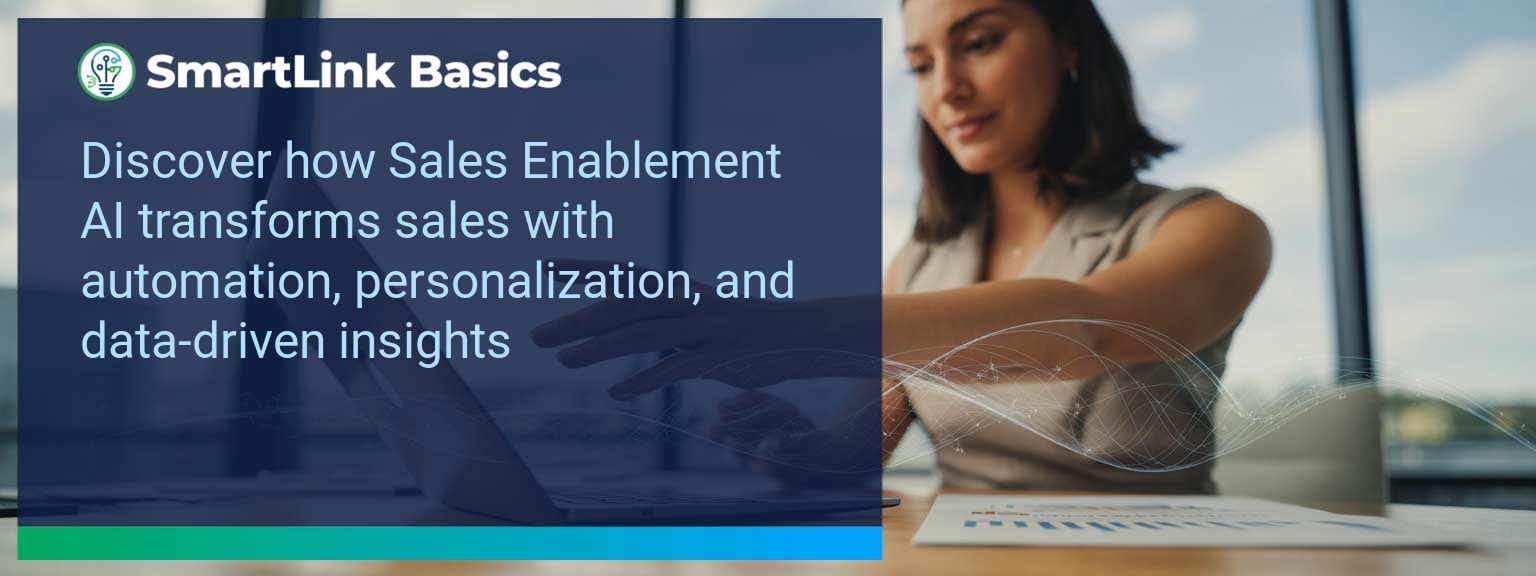Sales leaders face a pivotal shift. Traditional sales enablement approaches—manual playbooks, scattered training sessions, and generic outreach—are no longer sufficient in the era of digital transformation. Today, SmartLink Basics highlights how Sales Enablement AI is reshaping the way organizations train teams, engage customers, and drive deals forward. By fusing sales automation tools, predictive analytics, and CRM optimization, businesses can transform workflow integration and accelerate revenue operations. This article explores key use cases, real-world applications, and an actionable roadmap for sales leaders who want to harness AI in sales for measurable performance.
- AI enables precise customer targeting through predictive analytics.
- Sales automation tools streamline onboarding and training programs.
- CRM optimization improves collaboration across sales and revenue operations.
- Performance analytics guide data-driven strategy adjustments.
- AI-driven personalization drives higher customer engagement and conversion.
What Changed and Why Sales Enablement AI Matters Now
The pressure on sales teams has intensified with overloaded data streams, longer buying cycles, and expectations for hyper-personalized engagement. Sales Enablement AI reduces friction by turning data into insights and automating time-consuming processes. This shift allows revenue operations to allocate resources efficiently while empowering teams with accurate information at every stage. A practical example: AI-driven playbook recommendations automatically adapt based on ICP alignment and deal stage, ensuring sellers deliver context-rich interactions. Leaders who adopt these tools can expect faster decision-making, improved win rates, and tighter sales-performance alignment.
Redesigning the Revenue Operating System With Sales Enablement AI
ICP, Segmentation, and Targeting
Defining the right Ideal Customer Profile (ICP) is no longer static. AI in sales adapts continuously by analyzing buyer intent signals, market shifts, and historical performance. With predictive analytics, teams can prioritize accounts that match ICP attributes most likely to convert. Imagine an AI system that automatically recalibrates your target account list weekly as new competitive data emerges—this ensures finite resources are spent where impact is greatest.
Pipeline Architecture
AI-driven forecasting replaces traditional pipeline guesswork. Tools apply performance analytics to project win probability, spotlight stalled deals, and recommend corrective actions. For example, sales automation tools can flag when a deal lags past the average cycle time and propose next engagement steps. This proactive clarity prevents costly blind spots across workflow integration.
Plays and Messaging
Sales Enablement AI transforms messaging into a tailored asset instead of a static script. Natural language models build personalized outreach options based on persona, buying stage, and prior interactions. When integrated with CRM optimization, these plays allow every rep to deliver customer-specific context that boosts engagement. This accelerates trust-building and aligns directly with revenue operations goals.
Operating Cadence
Consistency across the sales organization comes from AI-enhanced operating rhythms. Scheduling tools guide managers on optimal coaching moments, while dashboards highlight team-level performance trends. A practical play: AI prompts managers to review one flagged call per rep per week, ensuring both quality oversight and efficiency. Over time, this cadence shapes predictable growth patterns tied to measurable outcomes.
Unlocking the Power of AI Driven Tools
Sales automation tools free high-performing reps from administrative drag. With digital transformation, onboarding and training become continuous and adaptive through AI-driven learning management systems. Teams no longer wait for quarterly training decks—AI recommends micro-learning modules based on performance gaps detected in CRM. This creates faster onboarding, higher engagement, and ongoing skill reinforcement.
Overcoming Inefficiencies In The Sales Process
Information overload once stalled productivity. Sales Enablement AI resolves this by consolidating real-time insights from CRM optimization, pipeline tools, and revenue analytics dashboards. Sellers interact with unified views instead of toggling through dozens of apps, streamlining workflow integration. The result: reduced friction, responsive customer interactions, and sharper alignment across the sales performance chain.
Measuring The Impact On Sales Performance
Adopting AI without measurement diminishes value. Organizations must track early signals, outcomes, and quality perceptions. Metrics should align with sales training efficiency, pipeline health, and engagement impact. AI-powered dashboards mix leading indicators (like engagement frequency) with lagging results (such as revenue attainment), ensuring accountability and guiding continuous improvement.
| Category | Metric | Definition | Target |
|---|---|---|---|
| Leading | AI-Recommended Account Engagements | % of outreach suggested by AI completed by reps | 85%+ |
| Leading | Onboarding Module Completion | % of AI-driven training modules finished in onboarding phase | 90%+ |
| Lagging | Monthly Revenue Attainment | % of revenue target achieved by team post-AI integration | 100%+ |
| Lagging | Pipeline Velocity | Average days for deals to move between stages | 20% faster cycle |
| Quality | Customer Interaction Quality Index | Feedback score based on personalization and relevance of sales calls | 8/10 or higher |
| Quality | Rep Enablement Alignment Score | Assessment of rep confidence in AI-driven tools and training | 85%+ |
Preparing For The Next Wave Of Innovation
Future growth will be defined by human-AI collaboration. As automation takes on manual tasks, sales leaders must steer focus toward relationship nurturing, strategy, and advanced deal coaching. Smart organizations will integrate cross-functional AI—linking marketing, CS, and sales into a unified revenue operations engine. The companies that achieve AI maturity will not rely solely on efficiency gains, but on amplifying customer trust through precision engagement.
Get the 90-day plan, coaching rubric, and dashboard template to operationalize AI in your enablement program.
Driving Sales Growth With AI-Powered Enablement Strategies
Sales Enablement AI is reshaping how teams operate, removing inefficiencies with automation and amplifying impact through personalization. We explored how revenue operations, performance analytics, and CRM optimization come together to boost measurable outcomes. The next step is adopting frameworks built for digital transformation at scale. Access more AI-driven sales enablement resources from SmartLink Basics to ensure your team leads this evolution with confidence.









